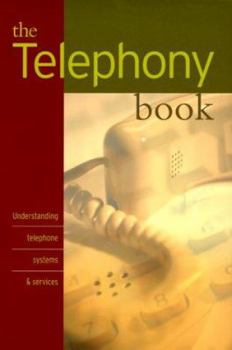The Telephony Book: Understanding Telephone Systems and Services
No Synopsis Available.
Format:Paperback
Language:English
ISBN:1578200350
ISBN13:9781578200351
Release Date:March 1999
Publisher:CMP Books
Length:320 Pages
Weight:1.05 lbs.
Dimensions:0.7" x 6.0" x 8.9"
Customer Reviews
2 ratings
"Mr. Watson. Come Here. I need you." ... AND, SO IT BEGAN ...
Published by Thriftbooks.com User , 19 years ago
It can be argued that the telephone is still the most important communications device on the face of the earth. All of this cannot be denied, despite the increasing ubiquity of desktop computers and e-mail. Author Jane Laino's has done an outstanding job of telling the movers and shakers of industry that they need not worry about continuing to do business solely with the telephone, while they regulate the computer functions to their assistants. Laino begins this 4th edition of the book by defining PBX as the term most used for business telephone systems. Next, the author identifies some of the areas organizations go wrong in identifying their requirements, which is followed by a suggested approach for doing well. Then, she discerns the ACD or Automatic Call Distributor as a specialized type of PBX. Laino continues by presenting Voice Mail and the Automated Attendant together, because they are always almost the functions of the same system. In addition, the author describes call accounting as a tool to help organizations manage and control telecommunications expenses. She then provides you with an overview of what's happening in the telecom industry now, which may provide a basis for where things are likely to go. Laino next refers to the use of a touchtone telephone to request information from a computer database. This known as Interactive Voice Response or IVR. Also, according to Laino, "if your organization does not have a LAN, you may still implement most of the capabilities described in this book on a separate PC." The author then reminds you that the terms outside lines, circuits and network services, all refer to the same thing. Next, she presents you with some things to ponder, which relate to telecommunications transmission. Laino then covers the physical transmission medium called cable, which is fundamental to telecommunications systems and services. Then, the author provides you with an understanding of the different types of companies that make up the continually changing telecommunications industry. Finally, she finishes up by presenting an historical perspective on the U.S. telecommunications industry. With the preceding in mind, the author has done an excellent job of explaining the telecommunications industry. At the end of the day, you'll find that the Telecom industry is varied and continually changing as the forces of both government and the marketplace continue to shape it.
Good explanation of the basics
Published by Thriftbooks.com User , 24 years ago
Ths book does not cover the nitty gritty of how many volts are used in a loop start connection, or the difference between D4 and ESF on T1 connections, but it does give a good overview of the basics. If you want to know, in easy to understand terms, how the phone system works, this is a good place to start.






